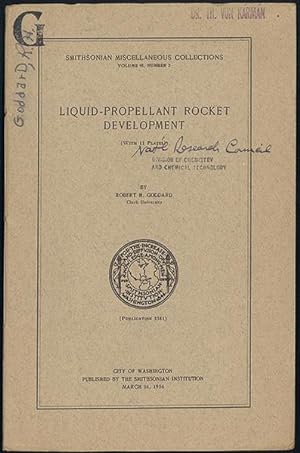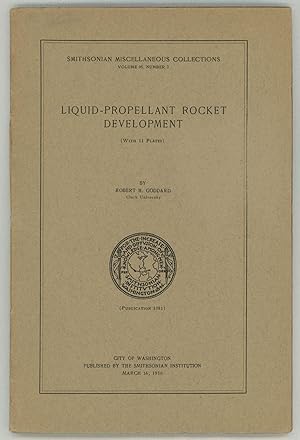Liquid Propellant Rocket Development by Goddard Robert (9 results)
Product Type
- All Product Types
- Books (9)
- Magazines & Periodicals
- Comics
- Sheet Music
- Art, Prints & Posters
- Photographs
- Maps
-
Manuscripts &
Paper Collectibles
Condition
Binding
Collectible Attributes
- First Edition (6)
- Signed
- Dust Jacket
- Seller-Supplied Images (6)
- Not Printed On Demand
Free Shipping
Seller Location
Seller Rating
-
Rockets: A Method of Reaching Extreme Altitudes/Liquid-Propellant Rocket Developments
Published by Dover Pubns, 2002
ISBN 10: 0486425371ISBN 13: 9780486425375
Seller: Revaluation Books, Exeter, United Kingdom
Book
Paperback. Condition: Brand New. 128 pages. 8.50x5.50x0.25 inches. In Stock.
-
Rockets: A Method of Reaching Extreme Altitudes/Liquid-Propellant Rocket Developments
Published by Dover Pubns, 2002
ISBN 10: 0486425371ISBN 13: 9780486425375
Seller: Revaluation Books, Exeter, United Kingdom
Book
Paperback. Condition: Brand New. 128 pages. 8.50x5.50x0.25 inches. In Stock.
-
Liquid-propellant Rocket Development. Smithsonian Miscellaneous Collections Volume 95, Number 3, Publication 3381.
Published by Smithsonian Institution, Washington, DC, 1936
Seller: Milestones of Science Books, Ritterhude, Germany
Book First Edition
Soft cover. Condition: Very Good. 1st Edition. 8vo (235 x 155 mm). [2], 10 pp., 11 pages of plates of black & white photographs. Loose in original printed wrappers (repaired at fold). Preserved in customized folding case. Little age-toning of text, otherwise crisp and clean. ---- DSB V, p. 433. - FIRST EDITION. Often referred to as the father of modern rocket propulsion, Goddard's work laid the groundwork for NASA's space program. He received financial support from the Smithsonian Institution and the Guggenheim Foundation in the 1920's. This publication represents the core of his findings up to the date of its publication. "Goddard flew the first liquid-fuel rocket on 16 March 1926. The ten-foot rocket, nicknamed 'Nell' reached an altitude of 41 feet, traveled a distance of 184 feet and landed 2.5 seconds after lift-off in a cabbage patch. Although his list of firsts in rocketry was distuguished, Goddard was eventually surpassed by teams of rocket research and development experts elsewhere, particularly in Germany. By temperament and training Goddard was not a team worker, yet he laid the foundation from which team workers could launch men to the moon" (DSB). - Visit our website for additional images and information.
-
Liquid-Propellant Rocket Development
Published by Smithsonian Institution, Washington, D.C., 1936
Seller: Burnside Rare Books, ABAA, Portland, OR, U.S.A.
First Edition
Condition: Very Good. First Edition. First edition, first printing. Bound in publisher's tan string-bound wraps printed in black. Very Good with toning and general wear. Eagle stamp on circular paper adhered to title page. In March of 1926, Goddard launched the world's first liquid-propelled rocket in Auburn, MA, with a small group of witnessed including his wife and several research assistants from nearby Clark University. It reached nearly 41 feet high and crashed nearly 184 feet from it's launch, smashing on impact. Goddard mostly worked independently and was highly secretively-- this is the second of only two papers he published on rocketry, though his impact was immense. Goddard theories and work anticipated many of the developments that made space-flight possible, and he is considered one of the founding fathers of modern rocketry.
-
LIQUID-PROPELLANT ROCKET DEVELOPMENT
Published by Smithsonian Institution, Washington, DC, 1936
Seller: William Reese Company - Literature, ABAA, New Haven, CT, U.S.A.
10pp. plus eleven plates (2 or more images per plate). Octavo (24.5 x 16 cm). Original medium brown sewn printed wrapper, lettered in black. Small private collection bookplate on inside of front wrapper (stamped "Withdrawn"), thumb tip-size spot of darkening at extreme lower edge of upper wrapper, upper fore-tip faintly bumped, otherwise fine, with the section of plates largely unopened. First edition. Published as Smithsonian Miscellaneous Collections, Volume 95, number 3 (Publication 3381)."Includes the first public mention of Goddard's historic 1926 liquid-fueled rocket launch" - Ciancone. "Goddard worked out the theory of rocket propulsion independently . . . Having explored the mathematical practicality of rocketry since 1906 and the experimental workability of reaction engines in laboratory vacuum tests since 1912, Goddard began to accumulate ideas for probing beyond the Earth's stratosphere. His first two patents in 1914, for a liquid-fuel gun rocket and a multistage step rocket, let to some modest recognition and financial support from the Smithsonian Institution . . . With an eye toward patentability of demonstrated systems and with the aid of no more than a handful of technicians, Goddard achieved a series of workable liquid-fuel flights starting in 1926. Through the patronage of Charles A. Lindbergh, the Daniel and Florence Guggenheim Foundation, and the Carnegie and Smithsonian institutions, the Goddards and their small staff were able to move near Roswell, New Mexico. There, during most of the 1930s, Goddard demonstrated, despite many failures in his systematic static and flight tests, progressively more sophisticated experimental boosters and payloads, reaching speeds of 700 miles per hour and altitudes above 8000 feet in several test flights" - Dictionary of Scientific Biography. Ciancone, LITERARY LEGACY OF THE SPACE AGE: AN ANNOTATED BIBLIOGRAPHY OF PRE-1958 BOOKS ON ROCKETRY & SPACE TRAVEL 85.
-
Washington, The Smithsonian Institution, 1936. 8vo. In recent red full cloth with gilt lettering to front board. Published as part of "Smithsonian Miscellaneous Collections, Volume 95, Number 3, Publication 3381". A fine and clean copy. (2), 10 pp. + 11 photographic plates. First edition of Goddard's paper on liquid-fueled rocket development. Goddard is credited with creating and building the world's first liquid-fueled rocket and is often referred to as the man who ushered in the Space Age (Pendray, Rocket Development). By temperament and training Goddard was not a team worker, yet he laid the foundation from which team workers could launch men to the moon" (DSB). Goddard was secretive about his research and only published two papers" "A Method of Reaching Extreme Altitudes" (1919) and the present. Goddard launched the first liquid-fuel rocket on 16 March 1926 near Auburn, Mass. The ten-foot rocket, nicknamed "Nell" reached an altitude of 41 feet, traveled a distance of 184 feet and landed 2.5 seconds after lift-off in a cabbage patch. "Although his list of firsts in rocketry was distuguished, Goddard was eventually surpassed by teams of rocket research and development experts elsewhere, particularly in Germany." (DSB)."Like the Russian hero Konstantin Tsiolkovsky and the German pioneer Hermann Oberth, Goddard worked out the theory of rocket propulsion independently [.] Having explored the mathematical practicality of rocketry since 1906 and the experimental workability of reaction engines in laboratory vacuum tests since 1912, Goddard began to accumulate ideas for probing beyond the Earth's stratosphere. His first two patents in 1914, for a liquid-fuel gun rocket and a multistage step rocket, let to some modest recognition and financial support from the Smithsonian Institution [.] With an eye toward patentability of demonstrated systems and with the aid of no more than a handful of technicians, Goddard achieved a series of workable liquid-fuel flights starting in 1926. Through the patronage of Charles A. Lindbergh, the Daniel and Florence Guggenheim Foundation, and the Carnegie and Smithsonian institutions, the Goddards and their small staff were able to move near Roswell, New Mexico. There, during most of the 1930s, Goddard demonstrated, despite many failures in his systematic static and flight tests, progressively more sophisticated experimental boosters and payloads, reaching speeds of 700 miles per hour and altitudes above 8000 feet in several test flights" (DSB).
-
Washington, The Smithsonian Institution, 1936. 8vo. In recent red full cloth with gilt lettering to front board. Published as part of "Smithsonian Miscellaneous Collections, Volume 95, Number 3, Publication 3381". A fine and clean copy. (2), 10 pp. + 11 photographic plates. First edition of Goddard's paper on liquid-fueled rocket development. Goddard is credited with creating and building the world's first liquid-fueled rocket and is often referred to as the man who ushered in the Space Age (Pendray, Rocket Development). By temperament and training Goddard was not a team worker, yet he laid the foundation from which team workers could launch men to the moon" (DSB). Goddard was secretive about his research and only published two papers" "A Method of Reaching Extreme Altitudes" (1919) and the present. Goddard launched the first liquid-fuel rocket on 16 March 1926 near Auburn, Mass. The ten-foot rocket, nicknamed "Nell" reached an altitude of 41 feet, traveled a distance of 184 feet and landed 2.5 seconds after lift-off in a cabbage patch. "Although his list of firsts in rocketry was distuguished, Goddard was eventually surpassed by teams of rocket research and development experts elsewhere, particularly in Germany." (DSB)."Like the Russian hero Konstantin Tsiolkovsky and the German pioneer Hermann Oberth, Goddard worked out the theory of rocket propulsion independently [.] Having explored the mathematical practicality of rocketry since 1906 and the experimental workability of reaction engines in laboratory vacuum tests since 1912, Goddard began to accumulate ideas for probing beyond the Earth's stratosphere. His first two patents in 1914, for a liquid-fuel gun rocket and a multistage step rocket, let to some modest recognition and financial support from the Smithsonian Institution [.] With an eye toward patentability of demonstrated systems and with the aid of no more than a handful of technicians, Goddard achieved a series of workable liquid-fuel flights starting in 1926. Through the patronage of Charles A. Lindbergh, the Daniel and Florence Guggenheim Foundation, and the Carnegie and Smithsonian institutions, the Goddards and their small staff were able to move near Roswell, New Mexico. There, during most of the 1930s, Goddard demonstrated, despite many failures in his systematic static and flight tests, progressively more sophisticated experimental boosters and payloads, reaching speeds of 700 miles per hour and altitudes above 8000 feet in several test flights" (DSB).
-
Liquid-propellant rocket development
Published by Smithsonian, Washington DC, 1936
Seller: Jeremy Norman's historyofscience, Novato, CA, U.S.A.
First Edition
Goddard, Robert H. (1882-1945). Liquid-propellant rocket development. 10pp. 6 plate leaves. Washington, DC: Smithsonian Institution, 1936. 246 x 163 mm. Original printed wrappers; preserved in a cloth drop-back box. Fine copy. From the library of aviation and aerospace pioneer Theodore von Kármán (1881-1963), with his stamp and docketing on the front wrapper. Front wrapper inscribed "Nat'l Research Council," with stamp beneath reading "Division of Chemistry and Chemical Technology." First Edition. "Like the Russian hero Konstantin Tsiolkovsky and the German pioneer Hermann Oberth, Goddard worked out the theory of rocket propulsion independently . . . Having explored the mathematical practicality of rocketry since 1906 and the experimental workability of reaction engines in laboratory vacuum tests since 1912, Goddard began to accumulate ideas for probing beyond the Earth's stratosphere. His first two patents in 1914, for a liquid-fuel gun rocket and a multistage step rocket, let to some modest recognition and financial support from the Smithsonian Institution . . . With an eye toward patentability of demonstrated systems and with the aid of no more than a handful of technicians, Goddard achieved a series of workable liquid-fuel flights starting in 1926. Through the patronage of Charles A. Lindbergh, the Daniel and Florence Guggenheim Foundation, and the Carnegie and Smithsonian institutions, the Goddards and their small staff were able to move near Roswell, New Mexico. There, during most of the 1930s, Goddard demonstrated, despite many failures in his systematic static and flight tests, progressively more sophisticated experimental boosters and payloads, reaching speeds of 700 miles per hour and altitudes above 8000 feet in several test flights" (Dictionary of Scientific Biography). The secretive Goddard published only two papers on rocketry, "A Method of Reaching Extreme Altitudes" (1919) and the present work. The remainder of his work was documented in patents. This copy is from the library of aeronautics pioneer Theodore von Kármán, who in addition to directing the Jet Propulsion Laboratory at Caltech was also the founder of the Aerojet Engineering Corporation, one of the industrial giants of the jet age. "At Caltech, Karman and his students laid the foundations for aerodynamic design leading to supersonic flight" (Dictionary of Scientific Biography). .
-
LIQUID-PROPELLANT ROCKET DEVELOPMENT .
Published by Published by The Smithsonian Institution, City of Washington, 1936
Seller: Currey, L.W. Inc. ABAA/ILAB, Elizabethtown, NY, U.S.A.
First Edition
Octavo, pp. [1-2] 1-10, eleven pages of illustrations on six inserted plates, original tan wrappers printed in black, sewn, untrimmed. First edition. Smithsonian Miscellaneous Collections, Volume 95, Number 3 (Publication 3381). "Includes the first public mention of Goddard's historic 1926 liquid-fueled rocket launch" (Ciancone). Ciancone 85. Ley, Rockets, Missiles, and Space Travel, revised edition, 1957, p. 491. Interlibrum 270 #151. Tiny spot on rear cover, a fine copy. A superb copy. Enclosed in a custom quarter green leather clamshell box with leather spine label. (#160970).


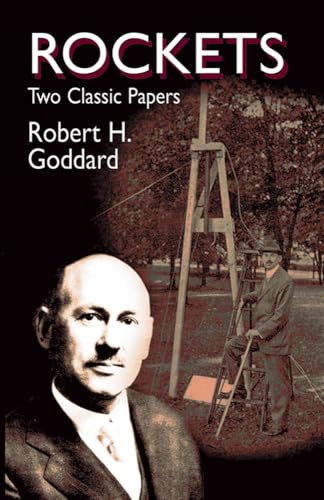
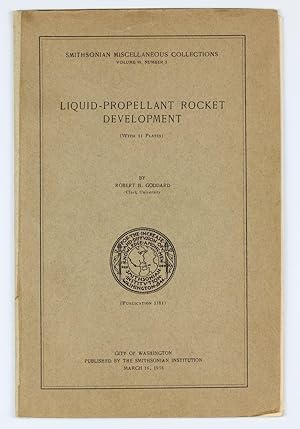

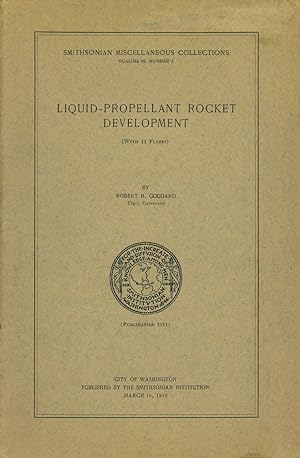
![Seller image for Liquid-Propellant Rocket Development (with 11 plates). - [THE WORLD'S FIRST LIQUID-FUELED ROCKET] for sale by Lynge & Søn ILAB-ABF](https://pictures.abebooks.com/inventory/md/md22268955714.jpg)
![Seller image for Liquid-Propellant Rocket Development (with 11 plates). - [THE WORLD'S FIRST LIQUID-FUELED ROCKET] for sale by Lynge & Søn ILAB-ABF](https://pictures.abebooks.com/inventory/md/md22525153882.jpg)
